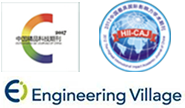Abstract:
Fabric types and forming process parameters are important factors that affect the quality of dry yarn fabric preforms. Taking plain weave carbon fiber fabric (PWF-C), plain weave glass fiber fabric (PWF-G) and non-crimp glass fiber braid (NCF-G) as the research objects, the influence of different preforming process parameters on the out-of-plane wrinkles and the size of the shear angle of the preforms was explored. Firstly, the Box-Behnken design (BBD) was used to establish regression models for out-of-plane wrinkles and shear angle respectively, and reliability analysis was carried out. Combined with the non-dominated sorting genetic algorithm (NSGA-Ⅱ), multi-objective optimization was conducted on the fabric types and process parameters of the preforming process to obtain the Pareto solution set. Subsequently, the Technique for Order of Preference by Similarity to Ideal Solution (TOPSIS) was adopted for decision-making to select the optimal solution. Finally, the final optimization results were verified through experimental methods. The results show that compared with fabric types and forming height, the number of out-of-plane wrinkles is most affected by the blank holder, and the number of out-of-plane wrinkles first decreases and then increases with the increase in the weight of the blank holder. Compared with fabric types and the weight of the blank holder, the shear angle is most affected by the forming height, and the shear angle increases with the increase in the forming height. The best results after multi-objective optimization using NSGA-Ⅱ are in good agreement with the experimental results, with an error of 0.95% for the number of out-of-plane wrinkles and an error of 1.71% for the shear angle. The above research results can provide guidance for the dry yarn fabrics preforming process.


 下载:
下载: